 |
| |
The Baby Boom - and other Poplation Explosions |
| Mississippi- like the entertainment industry - matures |
| America had just comeout of a nasty war - that radio played no small role in helping to win.We've already mentioned propaganda and the rallying cry that radio broughtto millions - but radio played a more direct role in winning the war: Armstrongencouraged the U.S. Government to build FM sets -without royalties - foruse by US troops in the war. Since no other country had FM equipment - thetransmissions were near impossible to intercept. And interceptions couldbe costly - the U.S. intercepted a coded message from Japan the told usexactly where Yamamoto would be and when - his plane never made it. Interceptedby U.S. fighters, it was shot down - killing the master strategist. TheU.S.'s lead in technology - particularly radio - contributed a great dealto the outcome of the War. In the 50's, America went about the business of growing. Pent-up demandfor consumer goods created a growth market that boiled over into huge inflationwithin 15 years. But in the 50's and early 60's - consumption was good -and keeping up with the "Jones'" was a full time occupation. Andof course - radio was right there fueling this with advertising campaigns-- sometimes so outrageous that they bordered on - and even crossing theline of deception and fraud. Any claim would do - if it got people to buythe product. At first - many stars of the big screen shunned television- it was an unknown - and it might be damaging to the star's dignity (spelledworth). Then a few stars were lured to television (and radio) by high-paying"endorsements" -- such as Dinah Shore for Chevrolet; It got sobad even Fred and Wilma were doing cigarette ads! Then everyone was on theair! The growth in at home entertainment changed the entertainment industryfor good - well - at least for ever: whether it was good or not dependson your outlook! This wing of the museum is kind of a catch-all: a few radios of the period- test equipment and other repair and dealer stuff; tubes; radio relatedcollectibles; and a few totally un-related things: Jimmie Rodgers; RailRoads; and other things Meridian, Mississippi. |
Consumer tube radios have changed very little from the end of the War tonow. The only area real advances took place in tube radio development wasin Auto Radios - the development of the 12V tube - a tube that uses 12voltsfor it's filament and 12V for plate supply - the tube's last stand againstthe transistor. The other area of hot development was for the military. Companies like Collins, Technical Materal Corporation; and Rockwell(who later ended up buying Collins) worked on some new concepts - pushingthe edge of technology -- and delivering radios that weren't juststate of the art - they defined the state of the art! TheR-390 / R391 / R390A series designed by Collins are considered to be amoungthe finest general covereage - general purpose receivers ever built. TheR-391 shown here made by Collins bears S/N 70 and has "Received for acceptance testing Signal Corps 11/23/1953" stamped on the back. Sensitivitysomething like S/S+n>10db=.1 microvolt; Auto-tune frequency repeatability300cps... Drift (after 24hr warmup - ovens on) less than 10 cps per day.The 390 has a standard multi-mu IF - fabulous for AM Radio DXing, etc. The391 adds to that 8 presettable channels (frequencies) that can be selectedand power tuned (within 300cps) automatically - locally or remote. The 390Aincorporates mechanical filters and other refinements - that make it theradio all others are compared against. Companies like Collins, Technical Materal Corporation; and Rockwell(who later ended up buying Collins) worked on some new concepts - pushingthe edge of technology -- and delivering radios that weren't juststate of the art - they defined the state of the art! TheR-390 / R391 / R390A series designed by Collins are considered to be amoungthe finest general covereage - general purpose receivers ever built. TheR-391 shown here made by Collins bears S/N 70 and has "Received for acceptance testing Signal Corps 11/23/1953" stamped on the back. Sensitivitysomething like S/S+n>10db=.1 microvolt; Auto-tune frequency repeatability300cps... Drift (after 24hr warmup - ovens on) less than 10 cps per day.The 390 has a standard multi-mu IF - fabulous for AM Radio DXing, etc. The391 adds to that 8 presettable channels (frequencies) that can be selectedand power tuned (within 300cps) automatically - locally or remote. The 390Aincorporates mechanical filters and other refinements - that make it theradio all others are compared against. |
 The last production tube radioswere from the mid-70's - and were usually clock-radios. The transistor,invented just after the War, was fragile and unreliable during it's firstfew years - which explains why - in spite of it's many advantages - manymanufacturers were very slow to replace the tube set. By 1960 the transistorwere becoming quite reliable - yet transistors didn't really dominate themarket for nearly ten years. Portable applications - because of the smallbattery requirement, etc. were where transistors were to make their mark.It took some time to overtake the whole market. The first commercial transistorwas the Regency TR-1 (currently about the hottest collectable in radio).As manufacturers gained faith in transistors - and the public discoveredthe world in their pocket for $10 - transistor radio production took off.It's estimated that of the 50 million radios manufactured between 1960 and1965 - the vast majority were transistor sets. Here are a few examples:Top Row - Left to Right: GE P2790D 1968; Westinghouse H707P6GPA 1965; TrueToneMIC3951 Brand Unknown -at least no one has been able to read it so far -On the Front in English: 602 6 transistor; the dial is MWleft to right 16 * 10 * 7 * 5.4 and below that is: 200*300**400***500*Mon the back molded into the case is a label - the top row is Chinese - thebottom says "MADE IN THE PEOPLE'S REPUBLIC OF CHINA" WEwould like to know more about this one! -- ClicPhoto. Bottom Row: MotorolaXP20DE 1966; Realtone 1248 1962(?) ; Hitachi Model TH-862R - "Marie"from 1960. The last production tube radioswere from the mid-70's - and were usually clock-radios. The transistor,invented just after the War, was fragile and unreliable during it's firstfew years - which explains why - in spite of it's many advantages - manymanufacturers were very slow to replace the tube set. By 1960 the transistorwere becoming quite reliable - yet transistors didn't really dominate themarket for nearly ten years. Portable applications - because of the smallbattery requirement, etc. were where transistors were to make their mark.It took some time to overtake the whole market. The first commercial transistorwas the Regency TR-1 (currently about the hottest collectable in radio).As manufacturers gained faith in transistors - and the public discoveredthe world in their pocket for $10 - transistor radio production took off.It's estimated that of the 50 million radios manufactured between 1960 and1965 - the vast majority were transistor sets. Here are a few examples:Top Row - Left to Right: GE P2790D 1968; Westinghouse H707P6GPA 1965; TrueToneMIC3951 Brand Unknown -at least no one has been able to read it so far -On the Front in English: 602 6 transistor; the dial is MWleft to right 16 * 10 * 7 * 5.4 and below that is: 200*300**400***500*Mon the back molded into the case is a label - the top row is Chinese - thebottom says "MADE IN THE PEOPLE'S REPUBLIC OF CHINA" WEwould like to know more about this one! -- ClicPhoto. Bottom Row: MotorolaXP20DE 1966; Realtone 1248 1962(?) ; Hitachi Model TH-862R - "Marie"from 1960.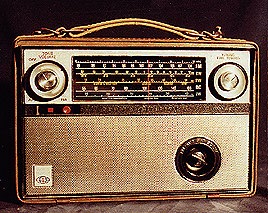 Up until 1964, Zenith was the undisputed champion of "portable"radios - the Transoceanic were unmatched in coverage and sensitivity. GEdecided to challenge them with a radio that had performance superior tothe trans.'s - and at a lower price point. The P990 World Monitor was theradio that was to meet those goals. This radio combined several interestingand very unconventional circuits into a radio that wasn't equaled in price/ performance for many, many years. One unusual design was in using commonbase amplifier stages. These stages - while difficult to design, can offerincredible gain. The AM (and ShortWave) section has 3 stages of IF amplification;while the FM section has 4 stages - most radios have 2 combined IF stages.Another unusual circuit is the electronic band-spread - or fine tuning.Taking advantage of the variable capacitance effect gained by varying thebias to a transistor, GE made an extremely "fine" tuning systemwith simple (and inexpensive) variable resistor. Zenith's approach was tohave many bands (8 or 9) and cover a small portion on each band - whichrequired more circuitry, and a very complicated (and expensive) band switchand dial system. One final "coup" - while the headphone jack willdrive a standard earphone or headphones just fine - the drive impedanceis optimized for 600 ohms - industry standard line level. Many P990s hadBFOs added - and with that output - they make an excellent Radio Teletypereceiver. Adding a BFO was extremely easy: copying the P990's local oscillatorcircuit - but using an IF transformer for the oscillator coil - the variableresistor would tune the BFO "through" the IF... making the receptionof code, Single Side Band and RTTY all possible. Though the World Monitorswere never to challenge the Transoceanic's in popularity - GE did accomplishtheir goal - an extremely sensitive - easy to operate - and affordable radio.This particular radio was found with it's original packing - including thehang tags, AC wall adapter and Chart book (in back pocket of the radio). Up until 1964, Zenith was the undisputed champion of "portable"radios - the Transoceanic were unmatched in coverage and sensitivity. GEdecided to challenge them with a radio that had performance superior tothe trans.'s - and at a lower price point. The P990 World Monitor was theradio that was to meet those goals. This radio combined several interestingand very unconventional circuits into a radio that wasn't equaled in price/ performance for many, many years. One unusual design was in using commonbase amplifier stages. These stages - while difficult to design, can offerincredible gain. The AM (and ShortWave) section has 3 stages of IF amplification;while the FM section has 4 stages - most radios have 2 combined IF stages.Another unusual circuit is the electronic band-spread - or fine tuning.Taking advantage of the variable capacitance effect gained by varying thebias to a transistor, GE made an extremely "fine" tuning systemwith simple (and inexpensive) variable resistor. Zenith's approach was tohave many bands (8 or 9) and cover a small portion on each band - whichrequired more circuitry, and a very complicated (and expensive) band switchand dial system. One final "coup" - while the headphone jack willdrive a standard earphone or headphones just fine - the drive impedanceis optimized for 600 ohms - industry standard line level. Many P990s hadBFOs added - and with that output - they make an excellent Radio Teletypereceiver. Adding a BFO was extremely easy: copying the P990's local oscillatorcircuit - but using an IF transformer for the oscillator coil - the variableresistor would tune the BFO "through" the IF... making the receptionof code, Single Side Band and RTTY all possible. Though the World Monitorswere never to challenge the Transoceanic's in popularity - GE did accomplishtheir goal - an extremely sensitive - easy to operate - and affordable radio.This particular radio was found with it's original packing - including thehang tags, AC wall adapter and Chart book (in back pocket of the radio). |
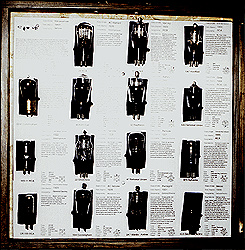 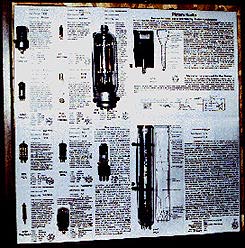 The radio and it's descendants are all a product of the vacuum tube.Their are many arguments who actually "invented" the tube - thetruth is that no one person did. Edison discovered the basics behindthe tube - by accident of course. While working to perfect the electriclamp - a problem he had was that metal boiled off the hot glowing filamentwould cool upon contacting the inside of the glass envelope - coating -and darkening - the glass. |
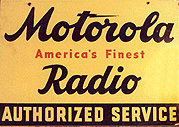  Radios spawned an entire new industry - with several new types of businesses:Early radio sales were handled by music stores and electronics supply housesthat just started out by putting a few sets for sale in a corner. By themid 30's "Radio Shops" had sprung up that specialized in radio:sales, service and support. Radios spawned an entire new industry - with several new types of businesses:Early radio sales were handled by music stores and electronics supply housesthat just started out by putting a few sets for sale in a corner. By themid 30's "Radio Shops" had sprung up that specialized in radio:sales, service and support. |
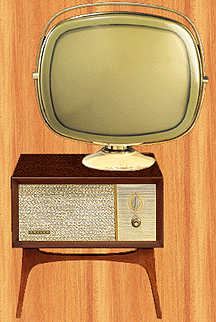 Even though this museum is dedicated to Radio - television is just radiowith pictures. Even though this museum is dedicated to Radio - television is just radiowith pictures. 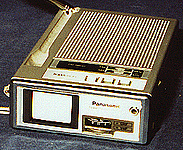 The Panasonic shown at right is from 1981 - very moderncompared to most of the sets displayed - the set includes AM/FM/FM Stereo- and a 125 channel continuous tuner for the television set - at 4.25"x6.75"x1.75and two pounds with batteries - it is truly pocket size. The TV at leftis one of the more unusual sets to have ever been commercially built. Inthe late 50's - Philco realized that their TV sales were sagging -- so waseveryone else's; the after -the-war boom was running out. Sputnik had justlaunched the space age - and people were caught up "in the future".Philco tasked it's engineering department to come up with a modernisticset that would reflect the space craze and hopefully cash in on the "futurecraze". Several sets having the "gimbal" mounted screen resulted- and were very successful. The wildest set was a unit designed with thetuner and most electronics in a very small box - and the 21 inch picturetube in it's now popular "gimbal" mount attached to the electronicsvia an "umbilical cord" allowing the controls to stay by yourseat - and the picture in front of you - to the limit of the 20 foot tether.This had to be one of the strangest forms of remote control ever! The PhilcoTandem was sold in 1960. The Panasonic shown at right is from 1981 - very moderncompared to most of the sets displayed - the set includes AM/FM/FM Stereo- and a 125 channel continuous tuner for the television set - at 4.25"x6.75"x1.75and two pounds with batteries - it is truly pocket size. The TV at leftis one of the more unusual sets to have ever been commercially built. Inthe late 50's - Philco realized that their TV sales were sagging -- so waseveryone else's; the after -the-war boom was running out. Sputnik had justlaunched the space age - and people were caught up "in the future".Philco tasked it's engineering department to come up with a modernisticset that would reflect the space craze and hopefully cash in on the "futurecraze". Several sets having the "gimbal" mounted screen resulted- and were very successful. The wildest set was a unit designed with thetuner and most electronics in a very small box - and the 21 inch picturetube in it's now popular "gimbal" mount attached to the electronicsvia an "umbilical cord" allowing the controls to stay by yourseat - and the picture in front of you - to the limit of the 20 foot tether.This had to be one of the strangest forms of remote control ever! The PhilcoTandem was sold in 1960. |
Radio Related Collectibles |
  Not all collectors collect radios - here are some radio related collectibles:These range from salt and pepper shakers: the TV set is really a salt andpepper shaker holder: turn the dial on the TV - and the salt and peppershakers pop-up; The "Nipper" pair salt and pepper are RCA giftsfrom 1936 - The stamps are from a series of U.S. stamps honoring the electronicsindustry - including Radio and Television, the Vacuum tube, etc. The CharleyMcCarthy doll is a reproduction from 1977. The lapel pin is a graduationpin from the National Radio Institute. Many war veterans acquired trainingfor a new job via mail order courses like those from NRI. Not all collectors collect radios - here are some radio related collectibles:These range from salt and pepper shakers: the TV set is really a salt andpepper shaker holder: turn the dial on the TV - and the salt and peppershakers pop-up; The "Nipper" pair salt and pepper are RCA giftsfrom 1936 - The stamps are from a series of U.S. stamps honoring the electronicsindustry - including Radio and Television, the Vacuum tube, etc. The CharleyMcCarthy doll is a reproduction from 1977. The lapel pin is a graduationpin from the National Radio Institute. Many war veterans acquired trainingfor a new job via mail order courses like those from NRI. |
| THE BACK CORNER Meridian, Mississippi is located on interstates 20/59 18 miles west ofthe Alabama border. Meridian is at the junction of a bunch of Highways andRailroads and is the home of the Meridian and Bigbee railroad as well. Meridianis the regional shopping, medical and cultural center for a population ofsome 300,000 of the South's finest. Meridian's Sons and Daughters all contributeto a proud ancestry and traditions that we celebrate and share with ourfriends and neighbors. There are several Museums located in Meridian: The Jimmie Rodgers Museum. Located in scenic Highland Park - just south of Meridian's Dentzel Carrousel.The Museum is open daily except Holidays - and has a large collection ofRodgers and Railroad memorabilia.  Known as the "Father of CountryMusic," James Charles Rodgers was born in Meridian, Mississippi onSeptember 8, 1897. Always in ill health, he became a railroad hand, untilill health caught up with him and he was forced to seek a less strenuousoccupation. An amateur entertainer for many years, he became a serious performerin 1925. Rodgers, who died in 1933, never appeared on any major radio showor even played the Grand Ole Opry during his lifetime. But he, Fred Rose,and Hank Williams were the first persons to be elected to the Country MusicHall of Fame in 1961, which is indicative of his importance in the historyof Country Music. Known as the "Father of CountryMusic," James Charles Rodgers was born in Meridian, Mississippi onSeptember 8, 1897. Always in ill health, he became a railroad hand, untilill health caught up with him and he was forced to seek a less strenuousoccupation. An amateur entertainer for many years, he became a serious performerin 1925. Rodgers, who died in 1933, never appeared on any major radio showor even played the Grand Ole Opry during his lifetime. But he, Fred Rose,and Hank Williams were the first persons to be elected to the Country MusicHall of Fame in 1961, which is indicative of his importance in the historyof Country Music.The Key Brothers Museum Currently located at the Airport Terminal, Key Field, Meridian Airport.Al and Fred Key were early pioneers in aviation - and in June, 1935 set a new world endurance record for flight of more than 578 hours. To accomplish this feat - the brothers are credited with inventing and perfecting several important aeronautical operations -- undoubtedly the most important of their achievements is in-flight re-fueling. The Meridian Railroad Museum Currently in reconstruction - as part of the downtown / Union Station project.The club and museum are housed in the old Railway Express Agent Buildingnext to the Amtrack station. Model railroading as well as exhibits of allthings railroad are on display. Because of the on-going construction - MeridianCity Hall / the mayor's office should be contacted for information. The Peavey Museum Located at the G.V. "Sonny" Montgomery IndustrialPark in NorthEast Meridian, the Peavey Museum holds hundreds of examplesof products manufactured by Peavey Electronics over it's 25+ years. Hartleysometimes has some of his many antique cars and antique Hi Fi equipmentand radios on display (of course Hartley is a member of the MississippiHistorical Radio and Broadcasting Society!). Merrehope - a restored ante-bellum home; and the F. W. Williams Homea restored Victorian house circa 1886 are open for daily tours. The Causeyville General Store opened in 1895 and is listed on the NationalRegister of Historic Places. Like Entering a time warp! Recently featuredlive on the FX channel. |
| Returnto the Lobby |
| Copyright © 1996, The Mississippi HistoricalRadio and Broadcasting Society. |
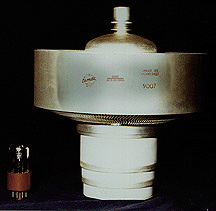 For his purposes, Edison had to stop thisbecause it blocked the light - something he didn't need. In experimenting- he found that the hot filament gave off an electron stream - variouslyeffected by other metal objects in the envelope - the polarity of each -and so on. He called this phenomenon "the Edison Effect" and founda way to minimize it and dismissed it as a pain in the butt. The EdisonEffect is the principal by which vacuum tubes operate. This was furtherexplored by Flemming in Europe - and deForest here. The two display caseshold samples of the various developments of the tube from the turn of thecentury. We hope to put together a better display of tubes here soon. Thelower picture is a modern Radio Transmitter tube (The power tube to a typical100, 000watterp FM transmitter). The Eimac 8990 - or 4CX20,000 - is capableof 28,000watts output. With a 12db antenna array - the effective radiatedpower is 100,000W. By the way: the tiny tube shown next to it is a fullsize octal tube!
For his purposes, Edison had to stop thisbecause it blocked the light - something he didn't need. In experimenting- he found that the hot filament gave off an electron stream - variouslyeffected by other metal objects in the envelope - the polarity of each -and so on. He called this phenomenon "the Edison Effect" and founda way to minimize it and dismissed it as a pain in the butt. The EdisonEffect is the principal by which vacuum tubes operate. This was furtherexplored by Flemming in Europe - and deForest here. The two display caseshold samples of the various developments of the tube from the turn of thecentury. We hope to put together a better display of tubes here soon. Thelower picture is a modern Radio Transmitter tube (The power tube to a typical100, 000watterp FM transmitter). The Eimac 8990 - or 4CX20,000 - is capableof 28,000watts output. With a 12db antenna array - the effective radiatedpower is 100,000W. By the way: the tiny tube shown next to it is a fullsize octal tube!